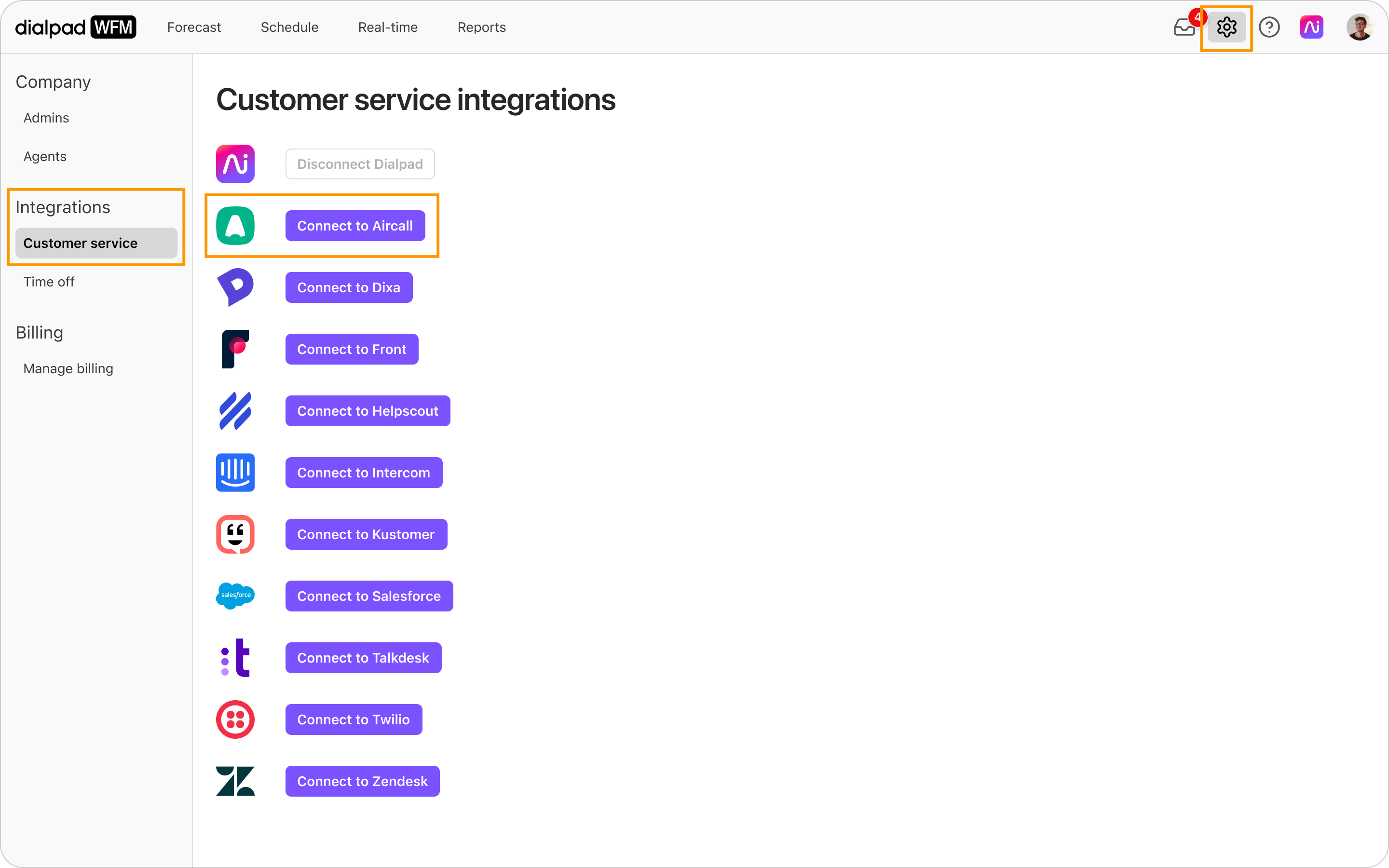Dialpad WFM's Aircall integration seamlessly pulls historical data from Aircall to provide valuable insights within your Dialpad WFM dashboard.
Once connected, you can:
View Actual Ticket Count: Accurately track the number of tickets handled through Aircall within Dialpad WFM.
Generate Accurate Forecasts: Leverage Aircall data to create more precise forecasts for staffing and resource allocation.
Monitor Agent Performance: Track agent performance metrics, such as call volume, average handling time, and attendance, directly within Dialpad WFM.
Who can use this
Dialpad WFM is available to all Dialpad users.
Contact your Customer Success Manager to discuss adding Dialpad WFM to your plan.
Integrate Aircall for forecasting
To set up forecasting or performance reporting with Aircall, first, you’ll need to connect to your Aircall account.
From your Dialpad WFM settings:
Navigate to Integrations
Select Customer service
Select Connect to Aircall

Enter your Aircall login credentials
Dialpad will download 12 months of historical ticket data from your Aircall account. This process will take 24-48hrs to complete, depending on your ticket volumes.
Set up forecasting with Aircall
Now that your Aircall account is connected, you can map your Aircall tickets to your queues.
First, you’ll need to create a queue for your Aircall tickets.
Select Forecasts
Select Queues
Select New queue
Name the queue
We recommend using the same name you use in Aircall.
From the connections dropdown, select Aircall
The 'real-time' and 'non real-time' setting does not apply to Aircall.
Now, use the Filter Queues section to choose which tickets you want to include in this queue.
You can filter tickets by:
cost
direction
duration
missed_call_reason
number_digits
number_id
status
tags
On the right, you’ll see a preview of the number of tickets you received in the last 7 days that match your filters. We recommend checking this against the data in your Aircall account to ensure you've set up the filters correctly.
Next, you need to enter the staffing parameters for this queue.
These inputs turn ticket volumes into a staffing requirement.
Average conversation/interaction time: The average handle time for the entire conversation.
Concurrency: How many interactions an agent can handle at once.
Tor phones, this should always be 1, as agents can only handle 1 call at a time.
Shrinkage: The percentage of scheduled time that's lost while agents work in this queue.
If you're not sure what you're shrinkage is, 30% is industry average.
Finally, you need to enter the service level (SLA) that you're trying to achieve.
This is target percentage of all tickets that should meet your first response time target.
That’s it! Your ticket group is now set up and ready to forecast, track coverage and agent performance.
Integrate Aircall for performance tracking
An additional integration, called a Webhook, is required to track agent performance in Intercom.
A webhook is like a doorbell for software apps - when something specific happens in one app, it automatically notifies another app immediately. This allows Aircall to provide WFM with real-time information on agent activity.
First, contact our team to get your integration URL.
Our team will generate a link and email it to you.
Then, log in to your Aircall dashboard (https://dashboard.aircall.io)
Select Integrations & API
If you do not see this option you likely do not have the correct permissions. Contact your admin to request them, or have them peform these steps for you.
Select Discover integrations
Select Webhook
Select Install integration
Name the integration
We recommend naming it Dialpad or Dialpad WFM
Paste in the URL our team will shared with you
Leave all events toggled on
Select Add webhook
Select Finish
You’ll be taken back to the Webhook Settings for the Webhook you just created — copy & paste the following details and share them with your Customer Success Manager.
The URL of the page
EX: "https://dashboard.aircall.io/integrations/webhook/webhook/12345"
The token shown in the General settings box
Our team will finalize the connection and you'll be ready to start tracking performance.
Once finalized, you’re ready to start linking activities with queues.
To correctly mark agent activity as 'on-task' or 'off-task', you need to define which activities are 'queue activities', i.e. agents should be working in Aircall at this time.
Navigate to the day view of the schedule
Select Add activities
Select the activity you want to link to a forecast
Select Edit
Toggle ‘Link to a forecast’ on
Select the queue(s) from the dropdown
Set-up is complete! You can now monitor agent's Aircall presence and activity in the real-time page and performance page.
Frequently asked questions
What ticket data does Dialpad retrieve?
Dialpad can only see your ticket volumes, not ticket content. Content is redacted when we collect your data.
Which agent actions are tracked in Aircall?
Dialpad WFM tracks agent’s interactions with calls in Aircall to create comprehensive activity timelines and performance metrics.
These interactions are categorized as follows:
Status Changes
Tracks when an agent changes the status of a call assigned to them (e.g., OPEN to CLOSED)
If a call is transferred the interaction will be attributed to the new assignee, not the agent who transferred the call
Records when calls are reassigned, including the first time it’s assigned
The interaction will be labeled with the call’s status at reassignment (e.g., OPEN)
The interaction will be attributed to the new assignee, not the agent who did the reassigning
Status changes to unassigned calls are not tracked
Dialpad WFM uses generic ticket status categories to fit with multiple integrations. The equivalent mapping for Aircall is as follows:
Ticket status | Aircall equivalent |
|---|---|
OPEN | Call answered |
ON-HOLD | N/A |
CLOSED | Call hungup |